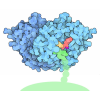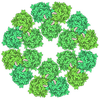+ Open data
Open data
- Basic information
Basic information
| Entry | Database: PDB / ID: 6i7t | |||||||||||||||
|---|---|---|---|---|---|---|---|---|---|---|---|---|---|---|---|---|
| Title | eIF2B:eIF2 complex | |||||||||||||||
 Components Components |
| |||||||||||||||
 Keywords Keywords | TRANSLATION / Translational control eIF2 Integrated stress response eIF2B TRANSLATION | |||||||||||||||
| Function / homology |  Function and homology information Function and homology informationnegative regulation of cellular response to amino acid starvation / positive regulation of cellular response to heat / Recycling of eIF2:GDP / Cellular response to mitochondrial stress / eukaryotic translation initiation factor 2B complex / ABC-family proteins mediated transport / methionyl-initiator methionine tRNA binding / eukaryotic translation initiation factor 2 complex / multi-eIF complex / cytoplasmic translational initiation ...negative regulation of cellular response to amino acid starvation / positive regulation of cellular response to heat / Recycling of eIF2:GDP / Cellular response to mitochondrial stress / eukaryotic translation initiation factor 2B complex / ABC-family proteins mediated transport / methionyl-initiator methionine tRNA binding / eukaryotic translation initiation factor 2 complex / multi-eIF complex / cytoplasmic translational initiation / protein-synthesizing GTPase / eukaryotic 43S preinitiation complex / guanyl-nucleotide exchange factor complex / formation of translation preinitiation complex / positive regulation of cellular response to amino acid starvation / eukaryotic 48S preinitiation complex / positive regulation of translational fidelity / regulation of translational initiation / Formation of the ternary complex, and subsequently, the 43S complex / Translation initiation complex formation / Ribosomal scanning and start codon recognition / L13a-mediated translational silencing of Ceruloplasmin expression / positive regulation of translational initiation / enzyme regulator activity / translation initiation factor binding / translation initiation factor activity / guanyl-nucleotide exchange factor activity / translational initiation / cytoplasmic stress granule / ribosome binding / ribosome / GTPase activity / mRNA binding / GTP binding / mitochondrion / RNA binding / metal ion binding / cytosol / cytoplasm Similarity search - Function | |||||||||||||||
| Biological species |  | |||||||||||||||
| Method | ELECTRON MICROSCOPY / single particle reconstruction / cryo EM / Resolution: 4.61 Å | |||||||||||||||
 Authors Authors | Adomavicius, T. / Guaita, M. / Roseman, A.M. / Pavitt, G.D. | |||||||||||||||
| Funding support |  United Kingdom, 4items United Kingdom, 4items
| |||||||||||||||
 Citation Citation |  Journal: Nat Commun / Year: 2019 Journal: Nat Commun / Year: 2019Title: The structural basis of translational control by eIF2 phosphorylation. Authors: Tomas Adomavicius / Margherita Guaita / Yu Zhou / Martin D Jennings / Zakia Latif / Alan M Roseman / Graham D Pavitt /   Abstract: Protein synthesis in eukaryotes is controlled by signals and stresses via a common pathway, called the integrated stress response (ISR). Phosphorylation of the translation initiation factor eIF2 ...Protein synthesis in eukaryotes is controlled by signals and stresses via a common pathway, called the integrated stress response (ISR). Phosphorylation of the translation initiation factor eIF2 alpha at a conserved serine residue mediates translational control at the ISR core. To provide insight into the mechanism of translational control we have determined the structures of eIF2 both in phosphorylated and unphosphorylated forms bound with its nucleotide exchange factor eIF2B by electron cryomicroscopy. The structures reveal that eIF2 undergoes large rearrangements to promote binding of eIF2α to the regulatory core of eIF2B comprised of the eIF2B alpha, beta and delta subunits. Only minor differences are observed between eIF2 and eIF2αP binding to eIF2B, suggesting that the higher affinity of eIF2αP for eIF2B drives translational control. We present a model for controlled nucleotide exchange and initiator tRNA binding to the eIF2/eIF2B complex. #1: Journal: Elife / Year: 2017 Title: Fail-safe control of translation initiation by dissociation of eIF2α phosphorylated ternary complexes. Authors: Martin D Jennings / Christopher J Kershaw / Tomas Adomavicius / Graham D Pavitt /  Abstract: Phosphorylation of eIF2α controls translation initiation by restricting the levels of active eIF2-GTP/Met-tRNAi ternary complexes (TC). This modulates the expression of all eukaryotic mRNAs and ...Phosphorylation of eIF2α controls translation initiation by restricting the levels of active eIF2-GTP/Met-tRNAi ternary complexes (TC). This modulates the expression of all eukaryotic mRNAs and contributes to the cellular integrated stress response. Key to controlling the activity of eIF2 are translation factors eIF2B and eIF5, thought to primarily function with eIF2-GDP and TC respectively. Using a steady-state kinetics approach with purified proteins we demonstrate that eIF2B binds to eIF2 with equal affinity irrespective of the presence or absence of competing guanine nucleotides. We show that eIF2B can compete with Met-tRNAi for eIF2-GTP and can destabilize TC. When TC is formed with unphosphorylated eIF2, eIF5 can out-compete eIF2B to stabilize TC/eIF5 complexes. However when TC/eIF5 is formed with phosphorylated eIF2, eIF2B outcompetes eIF5 and destabilizes TC. These data uncover competition between eIF2B and eIF5 for TC and identify that phosphorylated eIF2-GTP translation initiation intermediate complexes can be inhibited by eIF2B. | |||||||||||||||
| History |
|
- Structure visualization
Structure visualization
| Movie |
 Movie viewer Movie viewer |
|---|---|
| Structure viewer | Molecule:  Molmil Molmil Jmol/JSmol Jmol/JSmol |
- Downloads & links
Downloads & links
- Download
Download
| PDBx/mmCIF format |  6i7t.cif.gz 6i7t.cif.gz | 848 KB | Display |  PDBx/mmCIF format PDBx/mmCIF format |
|---|---|---|---|---|
| PDB format |  pdb6i7t.ent.gz pdb6i7t.ent.gz | 666.7 KB | Display |  PDB format PDB format |
| PDBx/mmJSON format |  6i7t.json.gz 6i7t.json.gz | Tree view |  PDBx/mmJSON format PDBx/mmJSON format | |
| Others |  Other downloads Other downloads |
-Validation report
| Summary document |  6i7t_validation.pdf.gz 6i7t_validation.pdf.gz | 1.3 MB | Display |  wwPDB validaton report wwPDB validaton report |
|---|---|---|---|---|
| Full document |  6i7t_full_validation.pdf.gz 6i7t_full_validation.pdf.gz | 1.4 MB | Display | |
| Data in XML |  6i7t_validation.xml.gz 6i7t_validation.xml.gz | 129 KB | Display | |
| Data in CIF |  6i7t_validation.cif.gz 6i7t_validation.cif.gz | 195.8 KB | Display | |
| Arichive directory |  https://data.pdbj.org/pub/pdb/validation_reports/i7/6i7t https://data.pdbj.org/pub/pdb/validation_reports/i7/6i7t ftp://data.pdbj.org/pub/pdb/validation_reports/i7/6i7t ftp://data.pdbj.org/pub/pdb/validation_reports/i7/6i7t | HTTPS FTP |
-Related structure data
| Related structure data |  4428MC  4404C  6i3mC C: citing same article ( M: map data used to model this data |
|---|---|
| Similar structure data |
- Links
Links
- Assembly
Assembly
| Deposited unit | 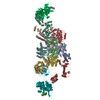
|
|---|---|
| 1 |
|
- Components
Components
-Translation initiation factor eIF-2B subunit ... , 5 types, 10 molecules ABCDEFGHIJ
| #1: Protein | Mass: 34062.027 Da / Num. of mol.: 2 Source method: isolated from a genetically manipulated source Source: (gene. exp.)  Gene: GCN3, AAS2, TIF221, YKR026C / Production host:  #2: Protein | Mass: 70945.195 Da / Num. of mol.: 2 Source method: isolated from a genetically manipulated source Source: (gene. exp.)  Gene: GCD2, TIF224, YGR083C / Production host:  #3: Protein | Mass: 42621.441 Da / Num. of mol.: 2 Source method: isolated from a genetically manipulated source Source: (gene. exp.)  Gene: GCD7, TIF222, YLR291C, L8003.17 / Production host:  #4: Protein | Mass: 81249.062 Da / Num. of mol.: 2 Source method: isolated from a genetically manipulated source Source: (gene. exp.)  Gene: GCD6, TIF225, YDR211W, YD8142.12, YD8142B.03 / Production host:  #5: Protein | Mass: 65768.320 Da / Num. of mol.: 2 Source method: isolated from a genetically manipulated source Source: (gene. exp.)  Gene: GCD1, TIF223, TRA3, YOR260W / Production host:  |
|---|
-Eukaryotic translation initiation factor 2 subunit ... , 3 types, 6 molecules KLMNOP
| #6: Protein | Mass: 34763.652 Da / Num. of mol.: 2 Source method: isolated from a genetically manipulated source Source: (gene. exp.)  Gene: SUI2, TIF211, YJR007W, J1429 / Production host:  #7: Protein | Mass: 31631.309 Da / Num. of mol.: 2 Source method: isolated from a genetically manipulated source Source: (gene. exp.)  Gene: SUI3, TIF212, YPL237W / Production host:  #8: Protein | Mass: 57942.699 Da / Num. of mol.: 2 Source method: isolated from a genetically manipulated source Source: (gene. exp.)  Gene: GCD11, TIF213, YER025W / Production host:  |
|---|
-Experimental details
-Experiment
| Experiment | Method: ELECTRON MICROSCOPY |
|---|---|
| EM experiment | Aggregation state: PARTICLE / 3D reconstruction method: single particle reconstruction |
- Sample preparation
Sample preparation
| Component | Name: Complex of translation initiation factors eIF2 and eIF2B Type: COMPLEX / Entity ID: all / Source: RECOMBINANT | ||||||||||||||||||||
|---|---|---|---|---|---|---|---|---|---|---|---|---|---|---|---|---|---|---|---|---|---|
| Molecular weight | Value: 0.838 MDa / Experimental value: YES | ||||||||||||||||||||
| Source (natural) | Organism:  | ||||||||||||||||||||
| Source (recombinant) | Organism:  | ||||||||||||||||||||
| Buffer solution | pH: 7.5 Details: Solutions for sample preparation were made fresh, filter sterilized, and degassed. | ||||||||||||||||||||
| Buffer component |
| ||||||||||||||||||||
| Specimen | Conc.: 0.28 mg/ml / Embedding applied: NO / Shadowing applied: NO / Staining applied: NO / Vitrification applied: YES | ||||||||||||||||||||
| Specimen support | Grid material: COPPER / Grid mesh size: 400 divisions/in. / Grid type: Homemade | ||||||||||||||||||||
| Vitrification | Instrument: FEI VITROBOT MARK III / Cryogen name: ETHANE / Humidity: 100 % / Chamber temperature: 294 K / Details: Blot for 1 second before plunging |
- Electron microscopy imaging
Electron microscopy imaging
| Experimental equipment |  Model: Titan Krios / Image courtesy: FEI Company |
|---|---|
| Microscopy | Model: FEI TITAN KRIOS / Details: Tilt at 35 degrees. |
| Electron gun | Electron source:  FIELD EMISSION GUN / Accelerating voltage: 300 kV / Illumination mode: FLOOD BEAM FIELD EMISSION GUN / Accelerating voltage: 300 kV / Illumination mode: FLOOD BEAM |
| Electron lens | Mode: BRIGHT FIELD / Calibrated magnification: 37313 X / Nominal defocus max: 3000 nm / Nominal defocus min: 1000 nm / Calibrated defocus min: 261 nm / Calibrated defocus max: 4601 nm / Cs: 2.7 mm / Alignment procedure: BASIC |
| Specimen holder | Cryogen: NITROGEN / Specimen holder model: FEI TITAN KRIOS AUTOGRID HOLDER |
| Image recording | Average exposure time: 10 sec. / Electron dose: 1 e/Å2 / Detector mode: COUNTING / Film or detector model: GATAN K2 QUANTUM (4k x 4k) / Num. of grids imaged: 1 / Num. of real images: 2154 Details: Images were taken with 40, 60 or 100 frames in total. The first 2 frames were discarded in motioncorr2. The stage was tilted by 35 degrees. |
| EM imaging optics | Energyfilter name: GIF Quantum LS / Energyfilter slit width: 20 eV |
| Image scans | Sampling size: 5 µm / Width: 3838 / Height: 3710 / Movie frames/image: 100 / Used frames/image: 2-100 |
- Processing
Processing
| EM software |
| ||||||||||||||||||||||||||||||||||||||||||||||||||||||||||||||||||||||||||||||||||||||||||||||||||||||||||||||||
|---|---|---|---|---|---|---|---|---|---|---|---|---|---|---|---|---|---|---|---|---|---|---|---|---|---|---|---|---|---|---|---|---|---|---|---|---|---|---|---|---|---|---|---|---|---|---|---|---|---|---|---|---|---|---|---|---|---|---|---|---|---|---|---|---|---|---|---|---|---|---|---|---|---|---|---|---|---|---|---|---|---|---|---|---|---|---|---|---|---|---|---|---|---|---|---|---|---|---|---|---|---|---|---|---|---|---|---|---|---|---|---|---|---|
| CTF correction | Details: CTF determination was performed per micrograph initially. After particle picking and initial reconstruction, per particle CTF determination was performed. Type: PHASE FLIPPING AND AMPLITUDE CORRECTION | ||||||||||||||||||||||||||||||||||||||||||||||||||||||||||||||||||||||||||||||||||||||||||||||||||||||||||||||||
| Particle selection | Num. of particles selected: 114390 Details: 2024 images were selected for particle picking. Initially, 3090 particles were picked manually and used for 2D classification into 20 classes. The best 8 classes (containing 2162 particles) ...Details: 2024 images were selected for particle picking. Initially, 3090 particles were picked manually and used for 2D classification into 20 classes. The best 8 classes (containing 2162 particles) were selected and used as references for automated particle picking in RELION. Particles on the lacey carbon, not in holes, were manually deleted in RELION, before extraction and further iterative cleaning by classification. | ||||||||||||||||||||||||||||||||||||||||||||||||||||||||||||||||||||||||||||||||||||||||||||||||||||||||||||||||
| Symmetry | Point symmetry: C2 (2 fold cyclic) | ||||||||||||||||||||||||||||||||||||||||||||||||||||||||||||||||||||||||||||||||||||||||||||||||||||||||||||||||
| 3D reconstruction | Resolution: 4.61 Å / Resolution method: FSC 0.143 CUT-OFF / Num. of particles: 23274 / Symmetry type: POINT | ||||||||||||||||||||||||||||||||||||||||||||||||||||||||||||||||||||||||||||||||||||||||||||||||||||||||||||||||
| Atomic model building |
| ||||||||||||||||||||||||||||||||||||||||||||||||||||||||||||||||||||||||||||||||||||||||||||||||||||||||||||||||
| Atomic model building | Source name: PDB / Type: experimental model
|
 Movie
Movie Controller
Controller



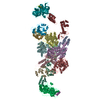
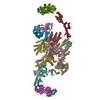
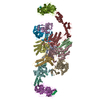

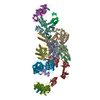
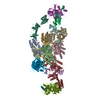
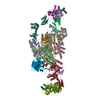

 PDBj
PDBj











